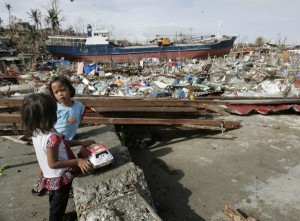President Benigno Aquino 3rd has created an inter-agency task group that will craft the rehabilitation plan for typhoon-ravaged Visayas, a Malacañang official announced on Friday.
In a press briefing, Presidential Communications Secretary Herminio Coloma Jr. said that a task group will present a comprehensive rehabilitation program that will be tackled by the Cabinet next week.
The plan will serve as basis for coordinating recovery and reconstruction efforts, including donor assistance.
According to Coloma, the President has directed the Cabinet “to hasten the transition of relief efforts into the full-scale rehabilitation and rebuilding of typhoon-damaged areas.”
Energy Secretary Carlos Jericho Petilla, who previously served as governor of Leyte, has been designated as “task group coordinator.”
Aquino also appointed representatives to a task force in charge of recovery and reconstruction.
Public Works Secretary Rogelio Singson will handle the construction of various infrastructures as well as the bunkhouses and temporary shelters for typhoon victims, Coloma said.
For livelihood and employment, the President assigned Agriculture Secretary Proceso Alcala, Trade Secretary Gregory Domingo, Labor Secretary Rosalinda Baldoz and Tesda Director General Joel Villanueva.
Social Welfare Secretary Corazon Soliman will focus on the resettlement and psychosocial care for the victims, while Environment Secretary Ramon Paje was tasked to ensure environmental protection.
Finance Secretary Cesar Purisima, Budget Secretary Florencio Abad and Foreign Affairs Secretary Albert del Rosario has been designated for resource generation and allocation.
Interior Secretary Mar Roxas, one one hand, will coordinate with the local government, Coloma said, adding that their “involvement is a key component of the rehabilitation program.”
The Palace official said that the task group will be guided by the conduct of a post-disaster needs assessment which will be supervised by Cabinet Secretary Jose Rene Almendras.
For his part, Economic Planning Secretary Arsenio Balisacan will oversee the planning coordination and NEDA will be in charge of synthesizing and integrating all proposed programs and projects for submission to the President and the Cabinet, he said
“The rehabilitation task group will be supported by the Cabinet clusters on economic development, poverty reduction and social welfare, climate change mitigation and adaptation, security and law and order, and good governance,” he added
Coloma also said that the President also instructed the Cabinet to create “a fine-tuned plan” that is “responsive to the specific needs at the community level is necessary.”
“It is important to enable the people to attain greater self-reliance while participating in the rebuilding of their communities,” he said.
The President also asked the help of local government units across the nation.
He tasked Gov. Aurelio Umali, president of the Union of Local Authorities of the Philippines (ULAP), “to mobilize the active participation of the Leagues of Provinces, Cities, and Municipalities and the Liga ng mga Barangay in concerted efforts to fully engage the citizenry at the grassroots level.”
As part of the rehabilitation program, Coloma said that the adopt-a-town concept initiated by the MMDA and Metro Manila mayors “will be replicated and expanded to include all the severely-hit municipalities and cities.”
Understanding, tolerance
Meanwhile, a representative of the United Nations appealed for public understanding and tolerance in light of the criticisms being hurled against those leading the relief efforts in Tacloban City and other typhoon-stricken areas of Visayas.
Bernard Kerblat, representative of the United Nations High Commission for Refugees, referred to the “judgmental statements” of the public about “what we should do” in light of the tragedy.
“I read some statements here that the government is not doing enough. How can we do if you’ve got the strength of a monster like Yolanda? Has anybody asked [Social Welfare] Secretary Dinky [Soliman] how many hours of sleep she had since that night?” Kerblat said.
“A bit of support, a bit of compassion, a bit of understanding . . . My message is very simple: I would like to appeal to the public opinion to be slightly more understanding, to be slightly more tolerant towards the government representatives who are in the ground day in and day out to extend support system compassion to their kababayans.”
The important thing for Filipinos to do is to “find a solution” and see the scope of the problem.
He commended the Department of Social Welfare and Development for doing an “incredible, commendable job,” and highlighted the need to acknowledge all of the “positive” things that have been done and continued to be done.
Fifty percent of the workforce of the Commission of Human Rights are still missing,
Kerblat said, so it is unfair to point at them and demand them to do their jobs in the areas affected by Super Typhoon Yolanda.
The local governments have also lost their loved ones, the official said, and yet “we expect them to continue to give their support and supplies to our kababayans.”
The resources of the government have been seriously depleted and the people overworked because of the disasters that have plagued the country since last year, the official said.
Kerblat noted that in this year alone, a typhoon ravaged Metro Manila in August, a military crisis ensued in Zamboanga in September and then Yolanda happened on November 8.
The Philippines, Kerblat said, has been confronted with 14 natural disasters with typhoons and political upheavals leading the way.
“The government civil service starting from the president all the way down were already affected. everybody was tired and yet what we see day in day out? We see the government still functioning,” he added.
Civil society groups as well as the social media have been criticizing the way the Aquino administration and the government officials in Tacloban City and other devastated areas have been handling the aftermath of the typhoon.


